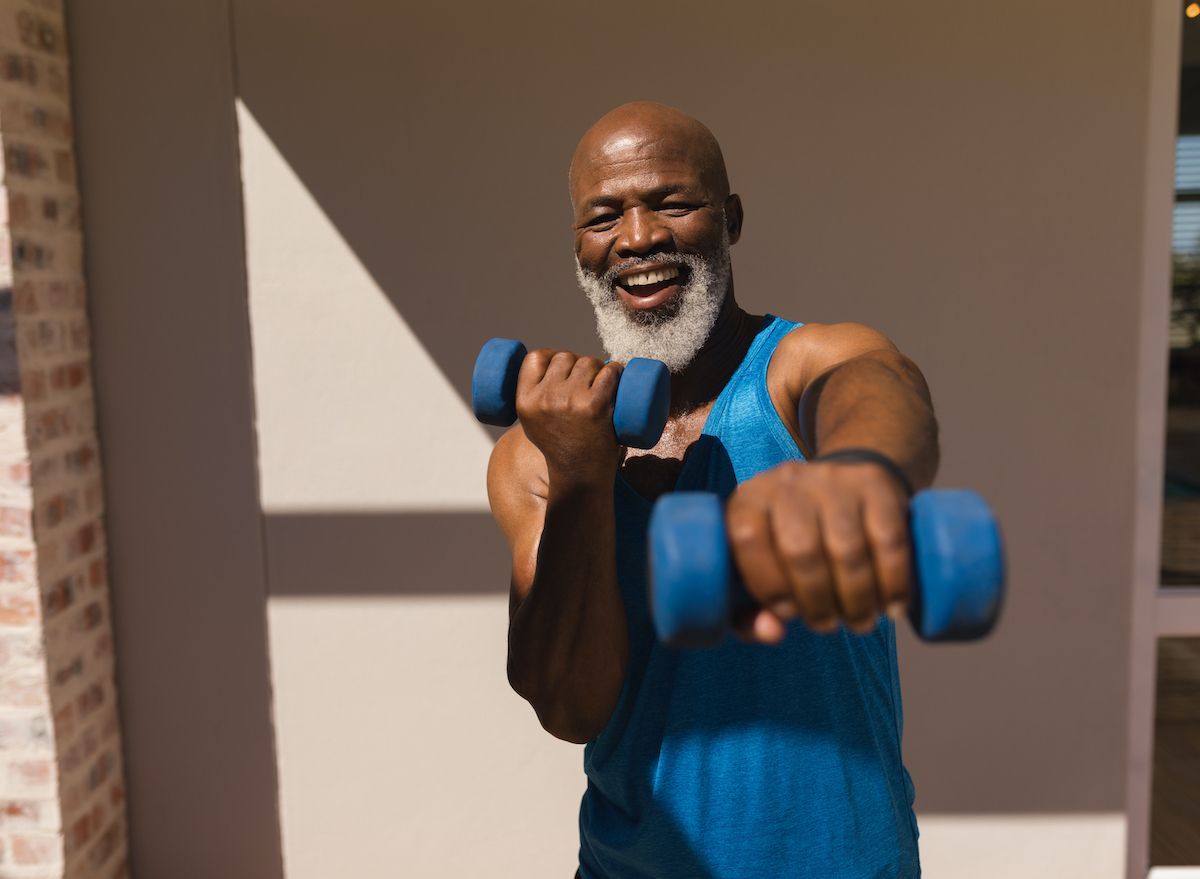Fitness
Here’s How Many Days a Week You Need to Exercise for Results

When my clients embark on fitness journeys, they often have a common question in mind: How many days a week should they exercise for results? If you’re in the same boat, you’ve come to the right place. Whether your goal is weight loss, lean muscle gain, or overall fitness, understanding the ideal number of days to dedicate to your workout routine is essential. Establishing the right balance ensures that you not only reach your fitness goals but also maintain a sustainable and enjoyable approach to exercise.
In this article, we’ll dive into how many days a week you need to exercise for results. In addition, we’ll explore the perfect combination of workouts for weight loss and lean muscle gain. We will also uncover the multifaceted benefits of regular physical activity, shedding light on how exercise contributes to a healthier weight and enhanced overall well-being.
Now, let’s get into the science of workout frequency and discover the path to achieving meaningful and lasting results. Keep reading to learn more, and when you’re finished, be sure to check out the 5 Most Effective At-Home Workouts for Weight Loss.
How many days a week do you need to exercise for results?

Finding the ultimate balance in your exercise routine is key to achieving optimal results, whether your goal is weight loss, muscle gain, or overall fitness. The number of days you should dedicate to exercise depends on various factors, including your fitness level, goals, and the type of workouts you engage in. According to fitness experts, a general guideline for adults is to aim for at least 150 minutes of moderate-intensity aerobic activity or 75 minutes of vigorous-intensity aerobic activity per week, coupled with muscle-strengthening activities on two or more days a week. This equates to exercising most days of the week, promoting consistency and long-term benefits.
What is the ideal combination of exercise for weight loss and lean muscle gain?


To achieve both weight loss and lean muscle gain, it’s essential to incorporate a well-rounded exercise routine. Cardiovascular exercises, such as running, cycling, or swimming, are effective for burning calories and promoting weight loss. Aim for at least three to five days of moderate to vigorous cardiovascular exercise per week.
Additionally, strength training exercises, including weightlifting or bodyweight exercises, should be integrated into your routine two to three days a week. This helps build and tone muscle, boosting your metabolism and enhancing the overall fat-burning process.
Combining both cardio and strength training creates a powerful synergy that contributes to achieving a lean and fit physique.
How is exercise beneficial for weight loss and boosting one’s overall fitness?


Exercise plays a crucial role in weight loss and overall fitness, offering a myriad of benefits beyond just shedding pounds. Regular physical activity helps create a calorie deficit—essential for weight loss—by burning calories and increasing metabolism. Moreover, exercise promotes the development of lean muscle mass, which not only contributes to a toned appearance but also enhances the body’s ability to burn calories at rest. In addition to weight-related benefits, exercise positively impacts cardiovascular health, reduces the risk of chronic diseases, and improves mental well-being.
On the one hand, engaging in aerobic exercises, such as jogging or cycling, elevates heart rate and improves cardiovascular endurance. Strength training, on the other hand, enhances muscular strength, endurance, and bone density. The combination of both types of exercise creates a comprehensive fitness routine that addresses various aspects of health. Moreover, consistent physical activity has been linked to improved mood, reduced stress, and better sleep quality, contributing to a greater sense of overall well-being.
Tyler Read

Fitness
Fitness coach says ‘just cardio isn’t enough’; shares 1 exercise women over 35 must do to stay strong and healthy

As we age, our bodies naturally start losing muscle mass and bone density, which can affect strength, metabolism, and overall health. Many women over 35 notice changes in energy levels, weight distribution, and endurance, making it essential to adopt exercises that not only tone but also strengthen the body.
Tara LaFerrara, fitness coach and personal trainer, shares in her September 22 Instagram post why women over 35 should start incorporating strength training into their routines and how it can transform both body and health. (Also read: Doctor with 25 years experience warns ‘ghee-loaded meals, sugary chai’ harm South Asians’ health; shares 6 key insights )
Why does muscle loss matter after 35
If you are a woman over 35 and not doing any sort of strength training, Tara warns you’re in for a rude awakening. “I’m talking the moment that your body starts to slow down, get weaker, and feel like you hurt more,” she shares.
“It is not just ageing, it is muscle loss, and it starts way earlier than you think. After the age of 35, we start losing muscle every single year. And that muscle is so important because it is your metabolism, your bone density, your energy, and just the ability to bounce back when life throws things at you,” says Tara.
Can cardio and pilates alone keep you strong
She emphasises that cardio and Pilates alone aren’t enough. “You need to lift, squat, push, pull, and press. It’s not about getting bulky and muscular, it’s about getting strong enough to handle ageing on your own terms.”
Her advice is simple: “So if you’re tired of feeling like your body is working against you, start working with it. Pick up some weights. Your future self will thank you.”
Strength training after 35 isn’t just about aesthetics; it’s about maintaining health, mobility, and resilience. As Tara highlights, incorporating resistance exercises into your routine is one of the best ways to support your body through the natural changes that come with age.
Note to readers: This article is for informational purposes only and not a substitute for professional medical advice. Always seek the advice of your doctor with any questions about a medical condition.
This report is based on user-generated content from social media. HT.com has not independently verified the claims and does not endorse them.
Fitness
New Year’s Fitness Resolutions Start with Healthy Sleep | Newswise

Newswise — As the New Year approaches, many Americans are setting fresh intentions to eat better and move more — and new data show those habits may deliver an unexpected bonus: better sleep. According to a new survey from the American Academy of Sleep Medicine, 59% of adults say eating a well-balanced diet helps them sleep slightly or significantly better. Staying active throughout the day may also help improve sleep. According to the survey, adults say exercising in the morning (42%) or evening (46%) helps them sleep slightly or significantly better.
“Sleep is one of three pillars of a healthy lifestyle, including eating a well-balanced diet and incorporating regular physical activity,” said AASM spokesperson Dr. Kin Yuen. “When people make New Year’s resolutions or select their ‘nudge word’ for the year, they often prioritize diet and exercise. These changes don’t just support physical health—they also improve sleep.”
The findings suggest that New Year’s resolutions don’t need to be isolated goals. Improving one aspect of health, whether diet, exercise, or sleep, can create positive ripple effects across all three areas of wellness. This is especially true for younger adults, with those 25-34 being the most likely age group to say a well-balanced diet (64%) or exercise in the evening (60%) helps them sleep better.
“Sufficient sleep significantly reduces the risk of chronic illnesses, such as obesity, heart disease, and even depression and anxiety,” said Yuen. “Whether you’re improving your diet, increasing your activity level, or managing stress, prioritizing sleep gives you the energy and mental clarity needed to start the year strong.”
Here are some tips from the AASM on how to develop healthy sleep habits and reap all the benefits of your New Year’s resolutions:
- Create a consistent bedtime routine — Make sure you are giving yourself enough time to get the recommended seven or more hours of sleep per night.
- Make time in your daily routine for physical activity — Pick physical activities that you enjoy and that match your abilities.
- Eat a well-balanced diet — Try to meet the recommended daily servings of fruits and vegetables, grains, and protein.
- Disconnect from devices at night — Turn off all electronics at least 30 minutes to an hour before your bedtime to help prepare for sleep.
For more information, or to find a local AASM-accredited sleep center, please visit sleepeducation.org. View 2025 AASM Sleep Prioritization Survey results in the AASM newsroom.
###
About the Survey
The American Academy of Sleep Medicine commissioned an online survey of 2,007 adults in the U.S. The overall margin of error fell within +/- 2 percentage points with a confidence interval of 95 percent. Fieldwork took place between June 5-13, 2025, by Atomik Research, an independent market research agency.
About the American Academy of Sleep Medicine
Established in 1975, the AASM is a medical association that advances sleep care and enhances sleep health to improve lives. The AASM membership includes more than 9,500 physicians, scientists, and other health care professionals who help people who have sleep disorders. The AASM also accredits 2,300 sleep centers that are providing the highest quality of sleep care across the country (aasm.org).
Fitness
Circadian Fitness: New Research Heightens Debate Over the Optimal Time for Exercise

-

 Washington1 week ago
Washington1 week agoLIVE UPDATES: Mudslide, road closures across Western Washington
-

 Iowa2 days ago
Iowa2 days agoAddy Brown motivated to step up in Audi Crooks’ absence vs. UNI
-

 Iowa1 week ago
Iowa1 week agoMatt Campbell reportedly bringing longtime Iowa State staffer to Penn State as 1st hire
-

 Iowa3 days ago
Iowa3 days agoHow much snow did Iowa get? See Iowa’s latest snowfall totals
-

 Miami, FL1 week ago
Miami, FL1 week agoUrban Meyer, Brady Quinn get in heated exchange during Alabama, Notre Dame, Miami CFP discussion
-

 Cleveland, OH1 week ago
Cleveland, OH1 week agoMan shot, killed at downtown Cleveland nightclub: EMS
-
World1 week ago
Chiefs’ offensive line woes deepen as Wanya Morris exits with knee injury against Texans
-

 Minnesota1 week ago
Minnesota1 week agoTwo Minnesota carriers shut down, idling 200 drivers























